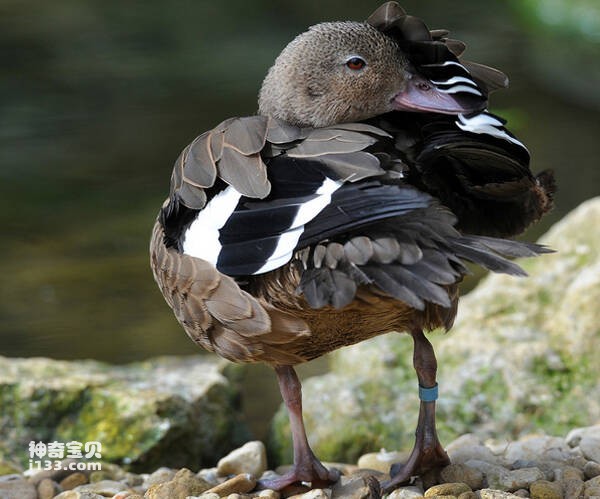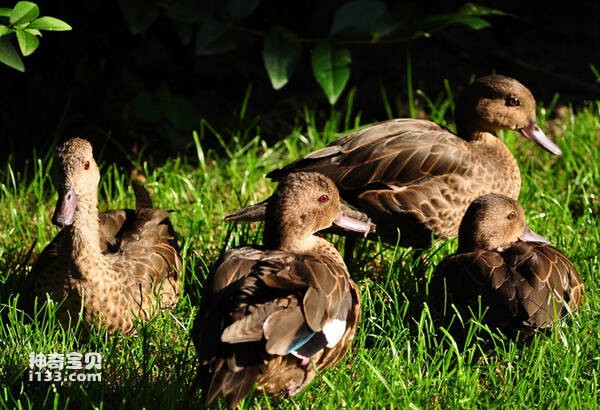Anas bernieri
IUCN
LCBasic Information
Scientific classification
- name:Anas bernieri
- Scientific Name:Anas bernieri,Madagascar Teal
- Outline:Waterfowl
- Family:
Vital signs
- length:40-45cm
- Weight:No textual research information is available
- lifetime:No textual research information is available
Feature
The whole body is brown with distinct black spots, especially on the sides and chest
Distribution and Habitat
It is found in the Indian Ocean island of Madagascar and nearby islands.
The main habitat is in wetlands and varies with the seasons. In the dry season, it appears in mangroves and shallow beaches on the edges of lakes and estuaries, mainly staying on river sandbanks with no or little vegetation, and in the rainy season, it prefers to drown in mangroves.
Appearance
The Falkland duck is a slightly smaller type of water duck. It is 40-45 cm long. Both males and females are brown with distinct black spots, especially on the sides and chest. The eye spots are black, the color of the head is lighter, gradually transitioning to grayish white, and the cheeks are grayish white. The tail feathers and tail overlying feathers are black, the primary feathers are also black, and the black rear part is very obvious against the orange color of the rest of the body; The tip of the secondary feathers is dark green with metallic luster, with a distinct white wing mirror; The wings are covered with black feathers, and the black corners of the wings have white patches.
Iris brown, beak pink-gray and slightly curved upward. Pink feet.
Details
The Madagascar Teal (Anas bernieri) is a slightly smaller teal.

The Falkisland ducks live in pairs during breeding period, live in family groups and small groups during non-breeding period, fly fast and stir fast with two wings. Good at swimming and diving, and good at walking. Can run lightly on the ground. Sexual alertness, often constantly stretching the neck to look around. Usually in pairs or small groups most are active at dawn and dusk. They also feed in shallow water and on the surface of the water. The staple food of invertebrates and plant roots is aquatic plant leaves, buds, seeds, seedlings and other plant foods, but also insects, crustaceans, mollusks, shrimp, water frogs, earthworms, small frogs and small fish and other animal foods. Sifting through the water with a beak while wading.
The breeding season of the Falklands duck occurs during the rainy season from December to March. A series of rituals precede mating, which takes place on the water; Before mating, the female duck walks around the male duck with her neck extended forward and her head lowered to the ground. She makes a "croak" call. At this time, the male duck also stretches his neck to the female duck, and then grabs the female duck's shoulder feathers and climbs onto the female duck's back for mating. Ducks nest in hollow tree trunks, especially in black mangroves. Monogamous, very territorial, actively defending their spawning grounds and showing no courtesy to intruders. Each nest produces about six eggs, incubated by the female bird alone, the male bird near the nest to guard, in case of danger to call a warning, and sometimes the male bird also flew to the intruder in an aggressive position to intimidate. They cover the eggs with feathers when they leave the nest, and then they go out with the males to forage. After the end of foraging, the male flies back to the nest with the female, and then leaves the female to roost near the nest. Incubation period 27-30 days. Young birds become young. When hatched, it is covered with feathers and can swim and dive. After six weeks the chicks leave the nest and begin to fly.

The Falklands duck faces a serious threat to its survival throughout its range, with widespread habitat loss disrupting speciation. Single subgroups are fragmented into fragmented habitats, all becoming inhospitable areas. Due to population isolation, limiting their ability to spread may result in a loss of genetic diversity. The main causes of endangerment are habitat loss, shallower water bodies becoming polluted, wetlands being reclaimed for rice cultivation, mangroves for timber harvesting or shrimp pond construction, and increased pressure on survival due to traditional hunting practices. During the spawning season, hunting by humans is the main threat. It is considered a delicacy and sold in the market.
Listed on the International Union for Conservation of Nature (IUCN) 2013 Red List of Threatened Species ver 3.1 - Endangered (EN).
Listed in the Washington Convention CITES Appendix II protected animals.
Listed in Appendices I, II and III of the Convention on International Trade in Endangered Species of Wild Fauna and Flora (CITES) 2019 edition Appendix II.
Protect wild animals and eliminate wild meat.
Maintaining ecological balance is everyone's responsibility!








